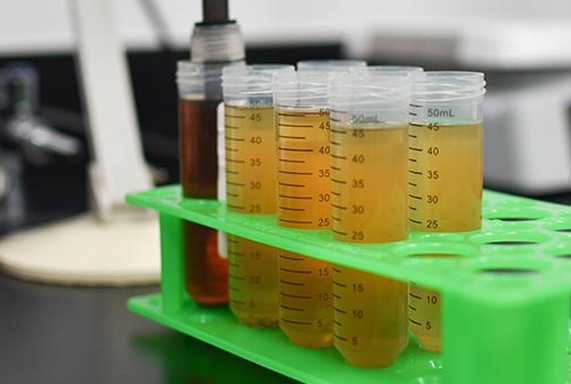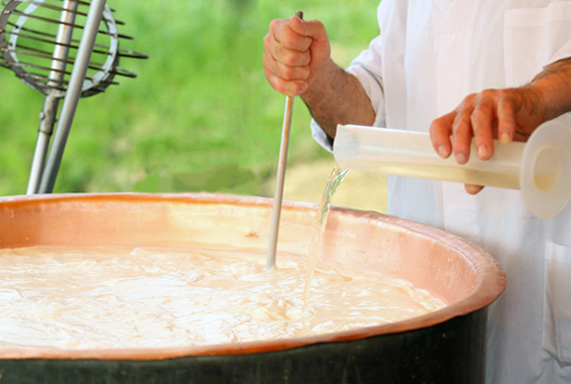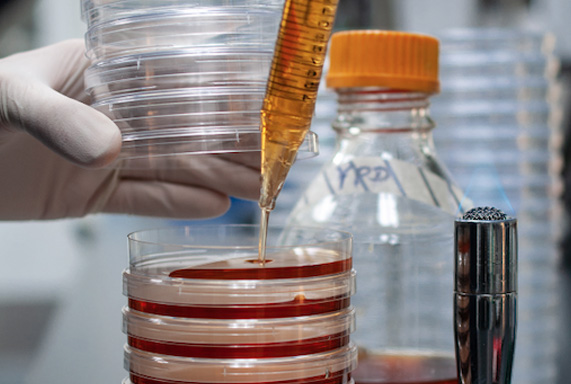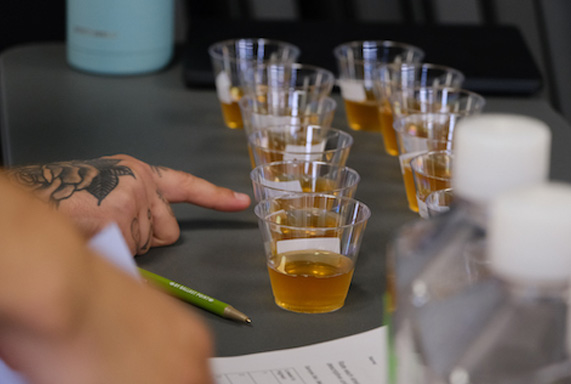| Term | Definition |
| Acidity | Acidity refers to the perceived tartness of the beer. The most common acid in regular beer fermentation is lactic acid. Lactic acid bacteria (LAB) is commonly used in sour beers. |
| Alcohol Tolerance | Here is a common classification of alcohol by volume percentages brewers yeast can survive in: * Low (2-5%) * Medium (5-10%) * Medium to High (8-12%) * High (10-15%) * Very High (15%+) * Varies |
| Ale | Ale is a broad category of beer which uses yeast known as Saccharomyces cerevisiae. In addition to being suitable for beer brewing, Saccharomyces cerevisiae includes strains of bread yeast, distiller's yeast and many laboratory yeast strains. Also known as top-fermenting yeast, brewers distinguish ale yeast by their behavior and flavor production. Ale yeast are typically used above 65°F and 18°C. |
| Attenuation | Attenuation is the percentage of sugars yeast consume during fermentation. Attenuation ranges are shown on each of our White Labs strains to help further your selection. Be sure to keep in mind the ranges are approximate. Several factors such as: mash profile, temperature, nutrients and oxygenation will affect the actual attenuation for each beer. |
| Bacteria | Bacteria in brewing are usually described as spoilage organisms. The bacteria intentionally used in brewing are most known for their acid production and ability to make "sour" beers. |
| Diacetyl | Generally undesirable, this byproduct of fermentation is characterized by a buttery, butterscotch-like aroma and slick mouthfeel. Diacetyl levels can vary from strain to strain. To minimize the diacetyl attributes in beer, it is recommended that the fermenting wort rest once the beer has reached terminal gravity for 48 hours at 62-70°F prior to crashing the temperature. This stage allows the yeast to reabsorb the diacetyl. |
| Enzyme | Enzymes are proteins that catalyze a reaction. Most of the chemical reactions that occur in brewing are catalyzed by enzymes, which are found in malt and yeast. Other enzymes, while not required for brewing, can have a helpful impact. Enzymes are active at very specific temperatures, and they can be denatured (unfold) very easily when the temperature is too high for optimal activity. Once unfolded, they will not reform into an active enzyme. For a full list of enzymes White Labs provides: Click Here |
| Ester | An ester is a volatile compound formed from an organic acid and an alcohol. It is esters that provide the fruity aromas and flavors that are found in some beer styles. Ester production vary from strain to strain |
| Fermentation | Fermentation in beer is the process of yeast converting sugars into alcohol, carbon dioxide, and a variety of flavor and aroma compounds. |
| Flocculation | Flocculation refers to the clumping of yeast cells and falling out of suspension at the end of fermentation often resulting in a clear beer. Strains are usually separated into three main degrees of flocculation - Low, Medium, and High. An example of a highly flocculent strain would be our WLP002 English Ale Yeast, which will settle at the bottom of the fermentation tank while WLP300 German Hefeweizen Ale Yeast being a low flocculant strain will stay in suspension much longer creating haze in a beer. |
| Fusel Alcohol | Fusel Alcohols are a form of alcohol which is a natural byproduct of yeast metabolism. Fusel Alcohols are usually described as warming, hot, and solvent flavors. Yeast strains vary in fusel alcohol production. In general, fermentation conditions that promote cell growth, such as temperature, aeration, and nitrogen, result in higher levels of fusel alcohols. |
| Gravity | Gravity is the amount of extracts in wort or beer. Extract is a combination of solids such as sugars, proteins, lipids, and minerals. The amount of extracts help determine how much alcohol can be produced by the yeast. Brewers sometimes refer to this unit as specific gravity, plato, or brix. The higher the gravity, the more alcohol can be created with proper yeast health and nutrition. |
| Lager | Lager yeast is usually known as Saccharomyces pastorianus. Sometimes referred to as bottom fermenting yeast, lager strains have the ability to ferment melibiose and ferment at cooler temperatures (48-55°F). |
| Lagering/Conditioning | Lagering is a beer’s maturation step, done after fermentation temperature, where beer is cooled to refrigeration temperatures. Usually performed with beers utilizing lager yeast, this maturation step allows yeast to clean up the beer as well as allowing solids to precipitate out of solution. |
| Nutrient | Nutrients consisting of amino acids, vitamins, and minerals are essential parts of a healthy fermentation. Not all fermentations are equivalent when it comes to nutrient availability and also vary for various yeast nutrient requirements. For a full list of nutrients White Labs provides: Click Here |
| Oxygen | Oxygen promotes yeast sterol production needed for lipids in yeast growth. Lack of dissolved oxygen at the start of fermentation can cause stuck or long fermentations, under attenuated beers, yeast stress,and off flavors. Proper levels of dissolved oxygen is just as important as using proper pitching rates. The usual dissolved oxygen rate is 8 to 10 parts per million(ppm) but can change depending on wort composition and yeast pitching rates. |
| Pellicle | A pellicle is a thin biofilm usually created by wild yeast and bacteria in the presence of oxygen. A pellicle can appear as a film reminiscent of bubbles or become spider web-like and its formation is expected by select organisms. |
| Phenol | Phenolic compounds are hydroxylated aromatic carbon rings that can be described as clove-like, smoky, spicy, and medicinal. The two most common phenolic compounds are 4-vinyl guaiacol(4-VG) and 4-ethyl guaiacol(4-EG), these compounds are produced when the yeast have an intact phenolic off-flavor gene(POF+). This aroma can be typical for a beer style or could be considered an off-flavor. |
| Pitch Rate | Pitch rate is a measurement of yeast added to wort or must. Pitch rates vary for style and beverage. Underpitching affects flavor more while overpitching negatively affects yeast health over generations. See the White Labs pitch rate calculator for additional information. |
| Primary Fermentation | Primary Fermentation indicates the initial phase of fermentation where yeast growth happens and most of the wort sugars are consumed. |
| PurePitch® | PurePitch® is White Labs' state of the art packaging technology, with our patented FlexCell™ technology. White Labs yeast is propagated in all-malt wort, providing the perfect nutrients for growth and optimal performance. Our breathable FlexCell™ technology also reduces risk of contamination by growing and delivering yeast in the same package. |
| Residual Sweetness | Residual sweetness is caused by the sugars remaining post-fermentation. Beers with high residual sweetness will usually have a fuller body and taste sweeter. |
| SCOBY | SCOBY is a Symbiotic Culture Of Bacteria and Yeast used to ferment teas (typically green or black varieties) into kombucha. For more information about how to use our SCOBY: Click Here |
| Secondary Fermentation | Secondary fermentation occurs after primary fermentation when the rate of fermentation decreases. Usually beer is racked off into a secondary vessel where aroma and flavor can mellow and yeast can settle out of suspension. For sour beers, usually wild yeast and bacteria are added during this stage. |
| STA1+ | The STA1 gene (glucoamylase), a potential indicator of Saccharomyces cerevisiae var. diastaticus. These strains have the ability to utilize some dextrins (unfermentable sugars) into fermentable sugars. At White Labs, we do everything possible to detect for undesired organisms within our process and cultures. The strains we carry with known Saccharomyces cerevisiae var. diastaticus genetics have been researched and validated to perform without excessive over-attenuating, which is possible through our nearly 25 years of experience paired with internal and external fermentation data. . |
| Strain | A strain is a subtype within a species. Think of this as all dogs are the same species, but each type of dog is a different strain. Strains can serve different purposes and styles in the brewing world. Visit the Yeast Bank to see White Labs collection of strains. |
| Sulfur | Yeast produce sulfur compounds, such as rotten egg or lit match aromas during fermentation, but these compounds are volatile enough that strong fermentation activity drives them from solution along with CO2. The key to reducing sulfur compounds is to have an active healthy fermentation. |
| The Vault | The Vault® is White Labs collection of unique and specialty yeast strains. They are available to all White Labs customers through the Vault Preorder, as well as seasonal strains and direct professional brewery orders. Lead times and minimum order quantity may apply. |
| Viability | Viability refers to yeast being alive or dead. If 5% of yeast in a given culture is dead the culture is 95% viable. The most common method for measuring viability is using a specific stain and microscopy to visually count a representative sample. |
| Wild Yeast | In brewing, wild yeast generally refers to genus of yeast that has not undergone the domestication of traditional brewers yeast like Saccharomyces cerevisiae and pastorianus. Wild yeast can also be in reference to yeasts unintended in a fermentation. |
| Yeastman | Yeastman is White Labs’ custom-built tracking and ordering technology. Yeastman tracks yeast throughout the building, regularly updates data between the internal and online systems, and provides up-to-the minute availability information for employees and customers alike. Yeastman is a Registered Trademark owned by White Labs that allows customers access to the entire White Labs catalog, online ordering, and access to all the testing data for your account and for your yeast. Yeastman also offers customized options for your account - including private strains, payment options, and varied shipping preferences. It is the largest online marketplace for specialty brewing yeast and related products. For more information go to https://yeastman.com/ |
 Yeast & Bacteria Bank
Yeast & Bacteria Bank
 Enzymes & Nutrients
Enzymes & Nutrients
 Lab Services
Lab Services
 Education
Education
 Merchandise
Merchandise
